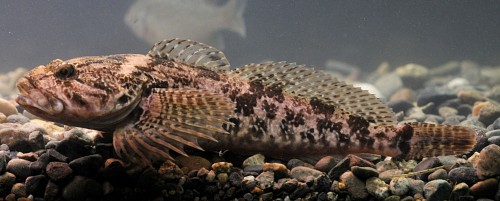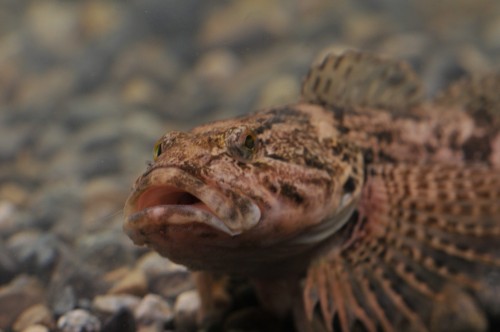Cottus asper
Identification Tips:
• Large head and mouth relative to body size
• Very large, fan shaped pectoral fins with dark banding
• Mottled dark brown, olive or gray above and on sides, whitish below
• Usually three dark irregular blotches or bars below rear dorsal fin.
• Caudal fin rounded without fork or notch
• Two dorsal fins: Front has 7 - 10 rays and dark spot at rear; Rear Dorsal18 - 23 rays
•Anal fin: 15 - 19 rays
•Both sexes show an orange band on the edge of the first dorsal fin at spawning time.
•Skin smooth to touch in head to tail directly , but prickly in reverse direction.
Conservation Status:
| British Columbia | Canada | Natureserve | |
| COSEWIC | Species at Risk Act | ||
| Not at Risk (Yellow List) | Not Assessed | None | S5, N5, G5 |
Information Source: BC Conservation Data Centre: http://a100.gov.bc.ca/pub/eswp/
Life History:
•A bottom-dwelling ambush predator.
•Feed mainly on bottom invertebrates and small fish, but also on snails and frogs.
•Migrate downstream in spring to spawn, to brackish water if near the coast.
•Males prepare nests under rocks, logs, or other debris.
•Larvae forage for zooplankton in water column for first 30-35 days.
•Mature in 2nd to 4th year and may live more than 7 years.
May reach 25 cm in length.
Habitat:
•Usually found over sand, or gravel in in quiet runs or pools of small to medium sized rivers.
•Sometimes in salt water near river mouths.
•Hides under submerged objects during the day; feeds actively at night.
•Moves to deeper water during the winter.
Range:
British Columbia
• Found throughout Fraser Valley and in most coastal streams, including on Vancouver Island and Haida Gwaii
•Genetically distinct form found across southern BC and in Peace River watershed.
Global
• Pacific Slope drainages from Alaska to California
• East of Rockies in Peace River drainage.
––––––
Primary Information Source:
McPhail, J.D. 2007. The Freshwater Fishes of British Columbia. University of Alberta Press. Edmonton, Alberta.



